I was really pleased to get to take my own personal Arduino board (that I bought form Sparkfun) along for this weeks futuretech slot on The Cool Stuff Collective. Being able to get kids, or anyone for that matter, interested in the fact that electronics and programming has never been more accessible with so many open source projects was really dear to my heart.
We actually filmed a lot more for the piece but I think the version we have in the show gets the point across. My willing volunteer had not done any electronics of programming before.
I showed the simple LED on off circuit as that was the least fiddly to build in front of the cameras, and would happily work in a few takes. I then patched in a version on another breadboard that had 2 LEDs so we can show that you can make your own toys, in this case a fire engine.
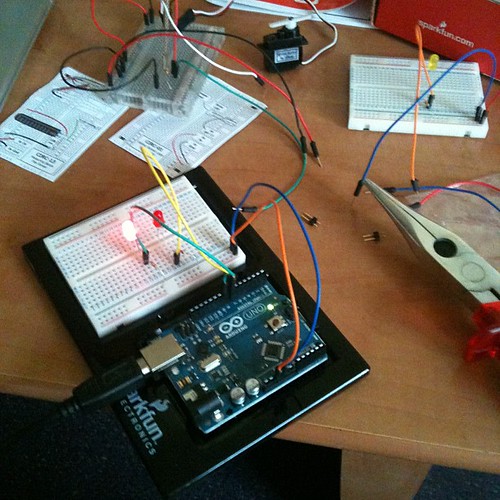
The other pieces with servos, sounds etc would actually fill a much longer programme. You could see that the Arduino, along with raspberry PI could fill a gap in make and do software and engineering that could help lift our general tech education in the country and help people realise that open source is a force for good that anyone can contribute too.
I built the circuits in the hotel room the day before the shoot. It looks suspicious to have all these wires and pliers nowadays!
If you are in the UK (Not sure it will work outside) the ITV player has this show for the next week until we have some even more cooler stuff on next weeks show.
It was also good on this show I got to be Stunf Fish as The Blowfish said he couldn’t ride a bike for gadget heaven and hell and we had an electric A2B bike to review. That was a fun, and surprisingly fast electric bike. I think I need to get some sort of electric vehicle!
Oh, and there was a double custard piefest as 2 of the 3 toys were voted Pants not Chilly hot on the cool stuff wall of fame. (Rubs hands with glee as the vengeful Supergeek!)
You have got to love kids TV!
technical
Gaming CAVE – Omnidirectional Treadmills.
The guys over at the Gadget Show look like they have put some great tech together here with a Battlefield3 CAVE with position sensing gun and an omnidirectional treadmill.
There have been a few of these doing the rounds, quite often in the virtual world space. Of course hooking up to an high end, very popular commercial game is one of those things that elevates the tech to commercial interest.
Ways to move in space without moving are really the last piece in the jigsaw puzzle of interaction. If we move out bodies, as we do with kinect, we are still restricted by the fixed screen. Or we have to wear headset screens in which case we can move around and be sensed moving by are restricted by the physical space around us.
So unless everyone learns the mime walking against the wind gesture we need something a bit more fancy to allow us to walk naturally.
It looks like this setup has some other haptic feedback, probably with the compressed air bullet hit jacket.*Correction as pointed out by Uncommon below, its actually rigged to fire paintballs as the player for haptic feedback. It looks very cool and exciting!.
On the road with The Cool Stuff Collective
This week saw the start of filming series 3 of The Cool Stuff Collective. I can’t say much about it until it airs but it was very different to be on location and staying away for 2 nights at a Premier Inn with the entire crew.
The first morning of filming was a difficult choice of wardrobe. Blue or Green? 😉
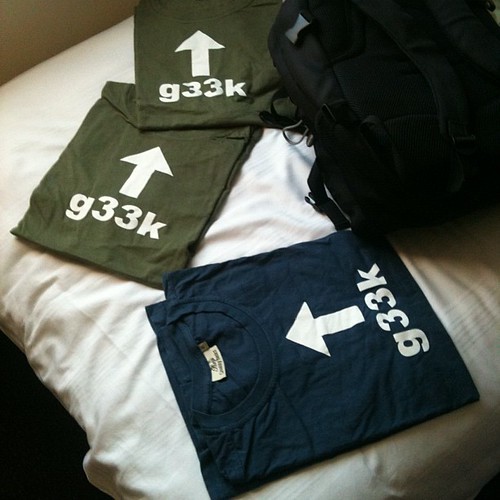
As resident “Super Geek” my mini sub brand marches on 🙂
It was good to see John Marley (the shows creator and boss of archie productions had his game face on too)

I also hope I did not worry housekeeping at the hotel too much with my day before prep of an item

The show will air in mid October (AFAIK) and I think its a cracker of a show.
Watch this space 🙂
More practical science in education – Let’s hope so!
Today a report came out from the UK government select committee on Science and Technology looking into the apparent lack of practical science work in schools that will create the next generation of scientists . It is heartening to see that the problem of a lack of practical science in schools has been identified. It is something that I have spoken about and also heard many others publicly express concern over.
It is a little concerning that some of the reporting is suggesting that it is the teachers in schools avoiding doing field trips and hands on science due to health and safety concerns and to curriculum pressure as if it was the teachers that created the league tables, measurement culture and paperwork. Most teachers want to excite and engage students, that is the point of the vocation. It is the policies around schools, the funding models and the generic nature of the curriculum that is the problem.
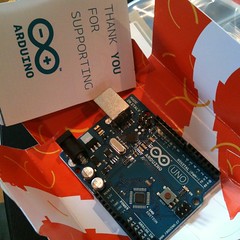
In the branch of technology that I work in there are plenty of opportunities for hands on practical work, programming, electronics, art, expression, logic etc. Much of what I try and help people with is things that they can just go and do, at relatively low of zero cost. That clearly can’t happen with some of the more physical sciences that require raw materials, or complex instruments but it is all about people getting to do and then share that creates interest. Being told and then measured really is not a sensible approach to inspire people of any generation.
As I wrote a few months ago about the excellent Raspberry PI project “There is also that realisation that developer community is shrinking, the grand masters are getting older, kids are not getting into programming. It’s not really even being taught.”
Whether you regard this as a science or an art or a branch of engineering the skills used in software development and understanding patterns of technology are relatively low cost to engage students with though it does need teachers who are programmers. I think there are few technical experts out there that want to change profession to teach ICT (which is basic use of of packages akin to learning to type). When I started as a programmer our teacher was from the industry, there were some keen hobbyist teachers too, but the main teacher has worked building systems. This, along with self teaching on easily accessible systems, was my grounding when I was in my early teens.
Now we have lots of unusual platforms, Opensim as a virtual world, Minecraft, Little Big Planet, Arduino hardware all available to encourage a generation of hackers, engineers and potential scientists just waiting to be rolled into more common school usage.
What am I doing about that then? Well short of going to train to be a teacher (now there is an idea!) I try and bring these things to the TV and to presentation and conferences, trying to show through practically doing things.
Of course if we miss a generation or two, separating them from technology and science in favour of paperwork we end up with a set of parents who will not be able to share the science with their kids. This in turn will lead to politicians, teachers and educators that also do not have that passion for science and tech. So we have no choice.
I know I gained an appreciation of large scale engineering and the challenges of it from my Dad working building ships. The trades (welding, plating, carpentry, technical drawing and design etc) all blended together into a very tangible and physical experience of what has to come together to make something as impressive as a large ship.
We need to make sure that whilst all the red tape and obsessive measuring is removed from education we keep the interest levels alive so that when the system is ready to enthuse the kids they haven’t given up already.
All in the aid of AR research
Here is another reason I should probably stick to using an avatar! This is AirBand on the Xbox Kinect. Which ever instrument you mime, guitar, drums or keyboard it picks up your position and lets you play the track (its kind of like a paperjamz guitar).
I hope mistsuzuki racing doesn’t mind the product placement of their shirt and logo in this piece 🙂
If you are having trouble with Kinect labs BTW, as it currently bluescreens for a lot of people then you can launch Air Band from the quicklaunch via the silver button menus, the save for Avatar Kinect.
I was trying to get footage of the predlets but they were getting so into it it was impossible to dive in and hit save on the video.
It is a pity you cant really play much in teh way of music it is a sequencer volume control, but can you imaging trying to do this 10 years ago? Brilliant fun and shows that AR doesn’t have to be all marketing and mapping
Expiranting on Nymwars with Avatar Kinect
Here is an experimental rant (expirant, of sorts) about Nymwars and why different identities are a choice we should be able to make. Using an avatar and a live recording starts to mix the virtual and physical. It is the same in any virtual world but I thought I would kill two birds (one real and one virtual) with a (mesh) stone and record something using Avatar Kinect which lets you use your body to puppet the avatar.
Just saying we should all have a direct tie to a physical face or name at all times it just plain silly. I guess most of us out here know that, but it has generated a lot of discussion on the web.
A very clever realtime 3d scanning using kinect
SIGRAPH 2011 always brings out some very interesting tech. I always think of it as being mainly high end very expensive leading edge graphics. This year though some researcher have provided something very cool and useful that side steps the expensive LIDAR scanning process to capture full 3d environments using just a (now) humble Kinect.
Point cloud data is often used to capture environments that already exist and then it is generally turned into a polygon mesh to be manipulated and re-rendered. Second Life is famously moving from its prim based display to start to allow these polygon meshes as that has been the traditional way yo show games graphics. However this is could all be up in the air a little with the guys at Euclideon who have this newer approach to rendering. Rather than polygons they use an atomic approach. it is really a 3d pixel or voxel.
So look out for Euclideon and their technology, it is an exciting time to see new and interesting ways for us to both create, interact and modify environments.
Both advances have implications for merging real and virtual spaces in either direction as part of augmented reality.
Develop conference Day 2 and 3. A wind of change?
In all the google+ messing around I had not got around to writing up my remaining thoughts and experiences at the Developer 2011 conference in Brighton. Day 1 for me was the Evolve conference a sort of future thinking bolt on that is gaining some traction with the industry. The Evolve strand then blends into the next 2 days which are the official Develop conference when everyone else turns up.

Breakfast Serendipity
The day started heading down in the lift from the 6th floor. I was already wearing my badge and a fellow delegate asked me at the lift where the registration desk was. we got chatting and then sat and had breakfast. The usual sort of conference chat, who are you what do you do. The bizzarre thing was that my fellow delegate was called Iain, (I am Ian of course). It also turned out we were both doing a presentation at 3pm that afternoon. This was Iain McCaig who was going to be doing the Art Keynote as an artist and conceptual designer. For those of you who don’t know he has worked on some the biggest movies and characters including creating Darth Maul! of all time. Clearly I was going to lose a “who does the coolest things” competition but we were actually talking about our shared interest in inspiring kids to create. For him it was drawing for me it was tech. We talked about 3d printing a bit too. As he is from the movie biz it was the first time anyone has said in a matter of fact way “yes we use those all the time”. I left breakfast completely inspired and to be speaking some of the same language and ideas as someone so successful gave me a real buzz.
More Media Molecule
In a reprise of last year the opening keynote was the guys from Media Molecule talking about their journey with Little Big Planet. It was done as an interview style with Phil Harrison. For anyone at previous Develops they will have heard many of these stories before. However it is interesting stuff. There was, of course a little more about Phil and Sony’s side of things. The key people who green lit LBP.
TV to Games and Back Again
The next session I popped into was part of the Evolve track, it was also in the room I would pitch in later so it all fitted nicely. Simon Harris of BBC worldwide explained the different approaches BBC Worldwide (the commercial arm of the BBC) is approaching tight integration of TV and games and the various other offline media. In many ways it was similar to the Moshi Monsters direction from the day before. It is not about bolt ons or after thoughts to cash in but about enriched branded experiences. There was a lot about Torchwood and how the growth of this to a US based series was also joined with specific threads being written for episodic games that track and augment the TV show. Top Gear also was very prominent with the deal to weave Top Gear into the Forza 4 experience. Though they did have to get Clarkson to re-record he dialogue as when it went to the certification boards it was not longer a 3+ game but had moved up to teen ranking. The future of the BBC in games and related interesting content seems assured with a lot of focus and investment and this very rich integration. A great session.
Mickey Mouse gaming
The post lunch keynote was the gaming legend David ‘elite’ Braben talking about of all things a virtual world 🙂 There were some amusing moments with the projector, that decided to clip the presentation (which did get sorted. Not a great picture but ‘king Disneyland’ made me laugh anyway.
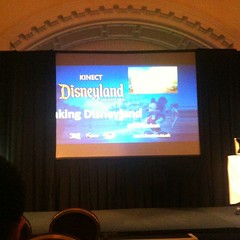
This virtual world is Frontier’s new game in conjunction with Microsoft and Disney. It is Disneyland adventures. They have completely and perfectly modelled the California disneyland and players are able to wander around the park using where they then join in in rides, quests, minigames etc. This did look very cool though we did see the same attract loop a good few times. David talked about the language of the Kinect and how we are all forming the vocabulary of interaction. In his game you navigate by pointing, but not with a tiring arm out point, but an elbow at your side at 90 degrees movement, using a turn of the shoulders to go left and right. The attention to graphic detail had to be obsessive as this is disney, and being a real place that millions have visited and will visit it had to be a mirror world location.
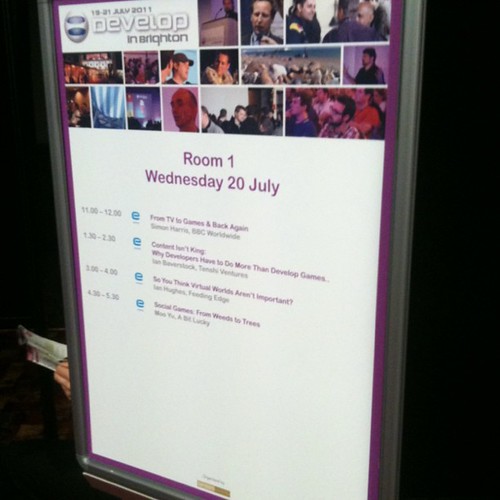
So you think virtual worlds aren’t important
This was me and my first foray into persuading people in the game industry of the changes brought about by virtual worlds and 3d printing. I gave a live demo of Opensim too. Of course The Cool Stuff Collective features as well as this is validation that if you don’t get this tech and its uses then next generation already are because we are telling them about it. I also dropped in unifier and kitely as examples of services that are evolving to support the demands for virtual worlds. This was very handy as I had an audience question that it was too much messing about to get into a virtual world to have a meeting. My answer was that people are trying to simplify it, but it is also based on demand. if the games industry applied its approaches to running and hosting, and to usability they would have a whole new market to reuse and expand into. They wont do that until they are made aware there is a need.
I also did a straw poll in the room of how many people had heard of the BCS. There was only 1 hand went up which is indicative of the work we have to do to help people in their careers in the games industry.
Raspberry Pi
It was back to David Braben again, this time at the other strand of the conference Games:edu. I already explained a little about this over here. Create a computing device so simple and cheap that allows kids to explore and program. As opposed to just being able to play and consume. This fills the chasm between the creativity of little big planet and other creative tools to the world of computer science. I am very hopeful as whilst we harped back to the 80’s back then we only had the computer to write code on. we did not have the feeder of the creative platforms, the virtual worlds and UGC were not a thing we experienced.
Day 3 – More 3d
Day 3 began rather like day 2 with a reboot of a previous years presentation. This was Mick Hocking of Sony talking about a year of PS3 3D. Last year it was a lot of slides and a quick demo we all had to crowd around. This year we were all in the Odeon with passive 3d specs on. It was a good pitch when we saw examples of design considerations actually played out in 3d. breaking planes, reversing images, forcing convergence and divergence past comfort levels. However a lot of it was 3d powerpoint which was really very annoying. It was a waste of the tech and the time to float bullet points IMHO.
I missed the next session as I was having a few meetings and conversations about beta’s and new tech with people.
Finally the next 2 sessions were the best of the entire conference.
Happily ever after: The Story of one girl’s refusal to delegate
Nat Marco from Honeyslug told a brilliant story of how she was persuaded into learning to code a game in LUA and XML by Ricky. I knew this would be good as I was enthralled at the Kahoots story last year from Honeyslug
How this led to a whole host of remote working relationships with artists around the world producing content for her. She also talked about the relationship with a script writer and how Nat made sure she imposed her own direction and creative will to keep her project how she wanted it to be. It was lighthearted, yet covered some very important points. The team that worked around Nat was global, it was not about co-location. The programming she had to learn was a start, and she saaid it was not as bad as she thought. She was also completely immersed (and supported in that immersion by a publisher) in the project in order to maintain its quality at every stage.
Another year down the gaming toilet
I met Ricky back at the first independent keynote I did at the ACE conference in 2009 and I know we share a lot of the same ideas and humour. Last year he told me I must go to this one particular session. I didn’t get to it but this year I made sure I did as it was running again.
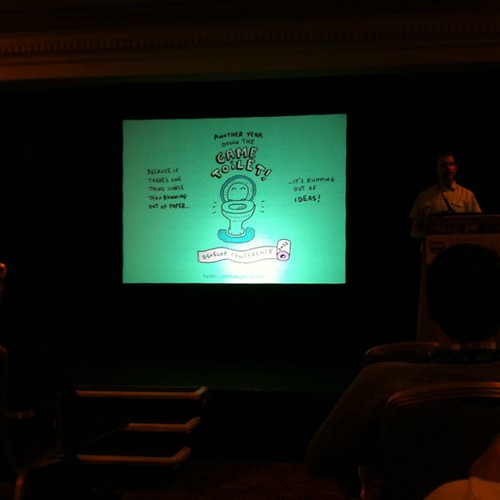
Jerry Carpenter is an artists and developer, he has spent years, each day on a bus on the way to work, writing down short crazy, eccentric and bizarre games ideas. He has a completely different presentation style to anyone else as it kind of rambles, bumbles then hits you square in the eyes with a flash of genius or comedy or both. His inspiration for describing mad/bad games was someone commented one of his games was like watching paint dry. So he made a watching paint dry game that you could only win by sitting watching the paint dry for 24 hours 🙂 So his entire site is now dedicated and full of these brilliant cartoons and succinct ideas for a game. Much of it is NSFW BTW :). I loved 1080 qwerty extreme – a game where you turn you keyboard upside down and stand on it to snowboard, and Ultimate feline optimal area tester (a cat swinging game in a room). The ideas do stand up on their own buy the way he tells about the train of thought had us all in stitches and was brilliant. He should have his own show 🙂 Much of what he shows hits at the heart of some of the terrible grind that is part of social gaming at the moment and is combined with film and political references too. if you get a chance to see him speak please go!
I decided I needed to get back home after that. I could not see anything topping those two sessions for inspiration so I headed on back, collecting all my 3ds spot pass new connections one the way. I look forward to another great conference next year.
This camera is amazing – no need to focus!
I saw a few tweets yesterday and I retweeted @JimMacMillan about a camera that does not need to focus. It is called Lytro, shoot now focus later It uses a technology called lightfield. I have only an inkling of how it works, but I need to read up on it now!. There are some simple explanations over at the Lytro site and for the more scientifically minded the CEO’s dissertation is there too
However it works though it is fascinating. A few of us back at the old firm I worked for had tried to work out how to take a photo using a regular digital camera but provide extra layer information so that the photo was in fact made of photoshop layers. It was not a great success, but we did try a few tricks to separate foreground and background. This however really does that with every point or beam of light in a scene. The ability to explore a photo zoom in on things that were not maybe the original intention of the photo is very Blade Runner.
I am guessing this has some significant implications for the 3d capture of scenes both from a photographic point of view but also that data will have some way to be processed in the future to create our 3d models. Combine Lytro style image capture with Kinect depth sensing, without the need for the multiple points of infrared light the kinect has to fire out. It would seem we have a leap in precision?
I am looking forward to finding out more and in the meantime check out their example photos and play spot the predator in one of them.
Identity is not binary – plusgate
I have to join in with support for those people out there who wish to use a pseudonym or handle to express themselves on the internet. This is all sparked out of the apparent short sightedness of Google and it Google+ on suggesting that if you don’t use your “real” name you can’t be on the “service”.
It is true that this is a free service, it is one, like most social networks that the owners can choose their own terms of service, however it is not an excuse to miss the point of all this connectivity.
The web is about people, social media is about people, virtual worlds are about people. People are not merely defined by a first name and second name and a physical home address. Those are merely an anchor point for physical services. People are defined by their actions, by their affiliations. They are also defined by the creative output. Social networks are not a forensic legal network of our DNA kept and logged with fingerprints, voiceprints and an absolute 100% certainty “we are who we say we are”. I am sure some people think that would be the ideal, however it is missing an important point.
Just because you know someones real name and potentially real address it does not mean that you know that real person. It no more indicates that they will tell you the truth or tell you a lie than if you ask them to roll a dice for you, 3 means truth 5 means lie the others are not sure.
People choosing to either use a different handle, a nickname or an AKA are not usually hiding. A few characters or a picture to express who they are in the context of a particular social network is more likely to offer insight into who they are rather than the surname handed down by birth and a first name given by parents.
Trust is very different from physical appearance or labelled identity. Having a human face profile picture does not make that profile “genuine”. The actions of someone or the organisation behind the profile are where trust is formed and where bonds are strengthened.
I can understand worries about accountability or security of knowing the same person is using the same account, but these are completely different from anonymity or pseudo anonymity. I am more than happy to talk and deal with the same person time and time again regardless of their “name” just as I am happy to deal with them regardless of race or creed. If the “name” they have made for themselves and their actions is an alias then so what?
Much of this has sparked form the virtual world communities, in particular Second Life choosing to help and early adopt Google+. In part to get away from the over controlling nature of Facebook and it’s names and identity policy. It seems though Google want to be a copy of that.
I am wondering where this ends though. Should we not be able to search the internet for fictional characters, are we not able to engage with people with imaginations online. Should everything be geared to a replication of the physical world?
It is lazy to treat identity as binary. I have seen corporations and companies try this with employees (and fail). We are complex messy collections of carbon atoms. We all have more than one mood and persona. Different situations require us to suspend disbelief or augment ideas. Nothing is black and white.
Does this affect me? Well not exactly. I am known as epredator on a number of systems. People call me epred when we meet. I am also Ian, Mr Hughes, Sir, Oi You, Dad, Son. I have an avatar in Second Life that wears a mask, yet I don’t hide behind that mask. I have not made a specific separation between me online and me offline in that I am shades of me and shades of characters in different situations at different times. I do however admire those who have a completely separate online nom de plume, why shouldn’t they? It is part of the magic of the human condition. Just as with a magic trick, once you know how its done it loses its appeal.
So, who ever you are, do not stifle creativity and creation, do not stifle humanity by fixing a technology based policy in place just because you think it “might be a good idea if…”. I reserve the right to have an anonymous profile that I can fill with whatever I want to explore a character and some ideas. Google “do no evil?” killing creative expression sounds rather evil to me?
